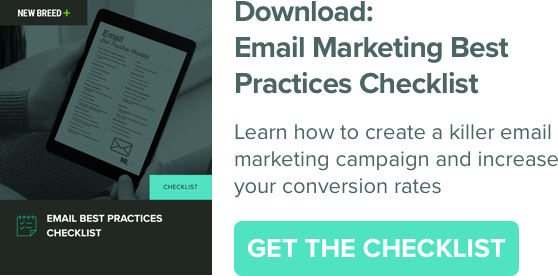
Despite the advent of alternative forms of digital communication, email use continues to flourish. When executed correctly, email marketing is a surefire way to inspire greater lead engagement and delight your audience by offering up relevant, personalized content. And when it's done wrong? We all know how annoying poorly-crafted email fodder can be. We've laid out five key ways to craft better performing email campaigns in 2019.
1. Capture the Right Lead Intelligence
Your ability to craft "smart" and relevant email campaigns that effectively capture the attention of your target audience depends on the quality and breadth of data you have to work with. Even the most advanced email management tools are only as capable as the lead intelligence that fuels them.
In order to be more granular in your segmentation and serve up more personalized content to prospects, you first need to capture the right lead intelligence and maintain the accuracy of the data you collect. Your form strategy should capture key, high-level information that helps you begin to identify a contact's persona group and funnel stage. But you shouldn't rely solely on forms to gather all the information necessary to score and segment leads. Your sales team should supplement any existing contact information in your system by conducting "lead enrichment" every time they connect with a contact, asking pointed questions to fill obvious data gaps.
If your marketing team relies on your sales team to input accurate data in order to create segmented list campaigns, then it's vital that whoever "owns" a contact at a given point in time takes responsibility for logging new data and updating information when changes occur, as this will directly affect the performance of a nurture campaign.
2. Use Smart Workflows
Once you have a wealth of data at your fingertips, the real fun can begin. Email workflows can take a few different forms depending on the goals of your campaign and the tools you use. "If/then" workflows offer a way to tailor campaigns in real time based on the interaction they garner, allowing you to serve additional opportunities to leads based on their engagement with previous emails. These types of workflows often boast higher open rates because they reduce the likelihood that your email went unacknowledged simply due to poor timing.
Another example of smart workflows are goal-specific workflows. Within your email workflow settings, you can opt to set a goal/expectation for a given campaign. This action will cause prospects to be unenrolled from the workflow once they've achieved that goal, preventing recipients from being inundated with additional, irrelevant emails in a drip campaign after they've already taken the desired action. Let's say you have a email campaign where the end goal is webinar registration. Setting registration as the goal for that workflow will effectively take prospects out of the workflow at whatever point they register for the webinar.
3. Create Smart Lists
Smart emails allow you to serve different offers within a single segmented email list based on specific defining criteria — in other words, they allow you to serve smart content to your audience. If you have three target personas, for example, each smart email in a single campaign workflow would be composed of three separate, persona-specific variations of your message.
Crafting smart emails also encompasses the ability to create smart lists. With the HubSpot smart list tool, you can use varying company and contact properties to create highly specific lists for targeted email campaigns. These lists could be segmented by persona, lifecycle stage, industry, firmographics or engagement level to effectively narrow down your audience to those contacts who are most likely to respond to an offer. So what actually makes these lists "smart?" Smart lists will continue to add new leads to an established workflow who fit the stipulated list criteria, so new leads will automatically enter relevant nurture campaigns.
4. Establish Appropriate Timing and Cadence
Timing is a huge factor affecting the performance of any email campaign. The "Schedule Based on Time Zone" feature in HubSpot automatically segments a list by a contact's local time zone, allowing you to send an email at a time when a contact is most likely to engage. Kicking-off workflows with one of the smart sending features is a good way to ensure that the first email in your drip campaign reaches its intended audience without slipping beneath the radar.
Establishing appropriate timing also includes considering how timely and relevant the offer is that you're promoting. It's equally important to double check that the content of your email provides necessary context surrounding the offer. For example, if you're sending an email campaign that asks recipients to register for a live webinar, it would be important to tailor the message to include workarounds for prospects in alternate time zones, perhaps including information like where/when the webinar recording will be available if the live session isn't convenient to attend. Providing differential context based on distinguishing factors will increase engagement levels by accommodating the unique needs of your audience.
5. Evaluate and Re-evaluate
When it comes to email campaigns, there's no magic formula or level of perfection that you can achieve and then apply universally. Nothing is static about the buyer's journey; just because a strategy worked for one target audience doesn't mean it will work across the board. That said, there are still ways to improve your overall success rates and learn from past mistakes.
Before creating a new email campaign, assess what worked and what didn't in your last campaign. Look at metrics like open rate, click-through rate and contacts lost over time and attempt to draw connections between significant dips or surges in engagement levels and key discriminating factors. Why did one campaign perform significantly better than another? Look at differences in content, timing, where contacts dropped off in the workflow, subject lines, number of emails and other potential distinguishing characteristics in correlation with the aforementioned metrics. Before creating a new email campaign, you should also look at delivery. If you'd like to see a greater delivery rate in your next campaign, it may be smart to exclude prospects on the current list that have demonstrated consistently low engagement rates.
When comparing different email campaigns, it's important not to compare apples to oranges (some campaign types have inherently lower engagement rates than others and certain contacts may not respond to the same strategies as others, for example). Monitor ongoing campaigns on a monthly basis to evaluate their performance thus far and make minor tweaks (or conduct A/B testing). As always, keep your end goal in mind when tailoring your message and determining the most apt strategy to use moving forward.
For more useful tips for creating engaging and effective email marketing campaigns, check out our Email Best Practices Checklist below.





